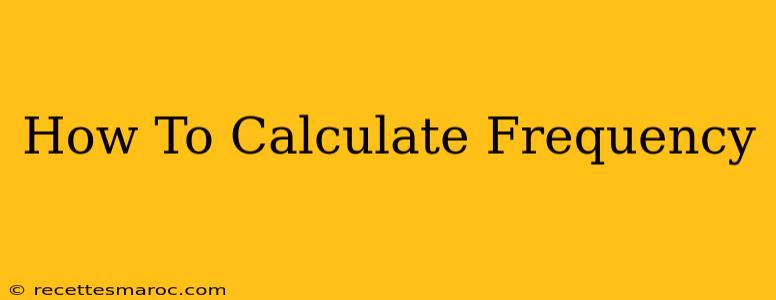Frequency, a fundamental concept in various fields like physics, statistics, and signal processing, measures how often something occurs within a given period. Understanding how to calculate frequency is crucial for analyzing data, predicting events, and designing systems. This guide will walk you through different methods of calculating frequency, depending on the context.
Understanding Frequency
Before diving into calculations, let's clarify what frequency means. It's the rate at which something happens, typically expressed as the number of occurrences per unit of time. The unit of frequency is Hertz (Hz), which represents one cycle per second. However, frequency can also refer to the number of occurrences within any given unit, such as events per meter, cycles per degree, or occurrences per year.
Key Terms
- Cycle: One complete repetition of a periodic event (e.g., a wave, oscillation).
- Period (T): The time it takes for one complete cycle to occur. The relationship between frequency (f) and period (T) is inversely proportional:
f = 1/TandT = 1/f. - Wavelength (λ): The distance between two consecutive corresponding points on a wave (applicable to wave phenomena).
Calculating Frequency in Different Contexts
The method for calculating frequency varies based on the type of data you are working with.
1. Calculating Frequency from Period
The simplest way to calculate frequency is when you know the period (T) of the event. As mentioned earlier, frequency (f) and period (T) are inversely related:
Formula: f = 1/T
Example: A pendulum completes one full swing (one cycle) every 2 seconds. Therefore, its period (T) is 2 seconds. To find its frequency (f):
f = 1/2 seconds = 0.5 Hz
The pendulum swings with a frequency of 0.5 Hertz or 0.5 cycles per second.
2. Calculating Frequency from Number of Occurrences and Time
If you know the total number of occurrences (N) of an event within a specific time interval (t), you can calculate the average frequency using this formula:
Formula: f = N/t
Example: A machine produces 120 items in 1 hour (3600 seconds). To calculate the frequency of production:
f = 120 items / 3600 seconds ≈ 0.033 Hz (or 0.033 items per second)
3. Calculating Frequency from Wavelength and Wave Speed (for Waves)
For wave phenomena (like sound or light), frequency is related to wavelength (λ) and wave speed (v):
Formula: f = v/λ
Example: A sound wave travels at 343 m/s (speed of sound in air) and has a wavelength of 1.715 meters. The frequency is:
f = 343 m/s / 1.715 m ≈ 200 Hz
4. Calculating Frequency in Statistics (Frequency Distribution)
In statistics, frequency refers to the number of times a specific value or range of values appears in a dataset. This is often represented in a frequency distribution table or histogram. There's no single formula here; the calculation involves counting the occurrences of each value.
Practical Applications of Frequency Calculations
Frequency calculations are used extensively in various fields:
- Physics: Analyzing sound waves, light waves, oscillations, and vibrations.
- Engineering: Designing circuits, signals, and communication systems.
- Medicine: Analyzing heartbeats (ECG), brainwaves (EEG).
- Music: Understanding musical pitch and tuning.
- Data Analysis: Determining the frequency of events in datasets.
Conclusion
Calculating frequency is a straightforward process once you understand the relevant formula based on the available data. Whether you're dealing with periodic events, wave phenomena, or statistical data, mastering these calculations is essential for analyzing and interpreting information across many disciplines. Remember to always ensure your units are consistent for accurate results.

